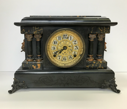Seth Thomas Clock Company does not have an image.
Seth Thomas Clock Company
American
American, (1853–1923)
Seth Thomas Clock Company was one of the most prolific and long lived clock companies. Seth Thomas was born in Wolcott, Connecticut in 1785, went to work for clockmaker Eli Terry in 1807, bought out Terry's factory (together with Silas Hoadley) in 1810, and in December 1813 bought out Heman Clark's clockmaking business in Plymouth Hollow. Thomas continued Clark's wooden movement tall clock production, and about 1817 began making the wooden movement shelf clock. These were cased in pillar and scroll cases until 1830, when the bronze looking glass and other styles became popular. In 1842, brass movements were introduced, and first cased in the popular O.G. case (which was made until 1913). Wood movements were phased out in 1845. In 1853 Mr. Thomas incorporated the Seth Thomas Clock Company, so that the business would outlive him. Mr. Thomas died in 1859, and Plymouth Hollow was renamed Thomaston in his honor in 1865. Mr. Thomas was very conservative, and after his death many new styles of clocks were introduced by his sons. Regulator clocks were introduced in 1860. The patterns and machinery for these had been purchased in 1859 from the creditors of bankrupt clockmaker Silas B. Terry. Spring driven clocks were introduced ca. 1855—1860. Perpetual calendar clocks were made from ca. 1863—1917. Some of the most popular later types include walnut kitchen clocks, made from 1884—1909; marble clocks, 1887—ca. 1895; black (Adamantine finish) wood mantel clocks, ca. 1885—1917; black enameled iron cased clocks, 1892—ca. 1895; oak kitchen clocks, 1890—ca. 1915; tambour clocks, introduced in 1904; chime clocks, introduced in 1909; and electric A/C clocks, introduced in 1928. In 1930 a holding company named General Time Instruments Corporation was formed to unite Seth Thomas Clock Company with Western Clock Company. In 1955, a flood badly damaged the Seth Thomas factory. They phased out movement manufacturing and began importing many movements from Germany. Hermle, in the Black forest of Germany, has made many movements for Seth Thomas clocks. In 1968, General Time was bought by Talley Industries, and in 1979 the headquarters was moved to Norcross, GA. In June 2001 General Time announced that it was closing its entire operation. The Colibri Group acquired Seth Thomas. The NAWCC (the National Association of Watch and Clock collectors) purchased from Seth Thomas their collection of historical records, drawings, photographs, advertisements and documents. Note: Many Seth Thomas clocks from 1881 to 1918 have a date code stamped in ink on the case back or bottom. Usually, the year is done in reverse, followed by a letter A—L representing the month. For example, April 1897 would appear as 7981 D.
Source: clockhistory.com
American
American, (1853–1923)
Seth Thomas Clock Company was one of the most prolific and long lived clock companies. Seth Thomas was born in Wolcott, Connecticut in 1785, went to work for clockmaker Eli Terry in 1807, bought out Terry's factory (together with Silas Hoadley) in 1810, and in December 1813 bought out Heman Clark's clockmaking business in Plymouth Hollow. Thomas continued Clark's wooden movement tall clock production, and about 1817 began making the wooden movement shelf clock. These were cased in pillar and scroll cases until 1830, when the bronze looking glass and other styles became popular. In 1842, brass movements were introduced, and first cased in the popular O.G. case (which was made until 1913). Wood movements were phased out in 1845. In 1853 Mr. Thomas incorporated the Seth Thomas Clock Company, so that the business would outlive him. Mr. Thomas died in 1859, and Plymouth Hollow was renamed Thomaston in his honor in 1865. Mr. Thomas was very conservative, and after his death many new styles of clocks were introduced by his sons. Regulator clocks were introduced in 1860. The patterns and machinery for these had been purchased in 1859 from the creditors of bankrupt clockmaker Silas B. Terry. Spring driven clocks were introduced ca. 1855—1860. Perpetual calendar clocks were made from ca. 1863—1917. Some of the most popular later types include walnut kitchen clocks, made from 1884—1909; marble clocks, 1887—ca. 1895; black (Adamantine finish) wood mantel clocks, ca. 1885—1917; black enameled iron cased clocks, 1892—ca. 1895; oak kitchen clocks, 1890—ca. 1915; tambour clocks, introduced in 1904; chime clocks, introduced in 1909; and electric A/C clocks, introduced in 1928. In 1930 a holding company named General Time Instruments Corporation was formed to unite Seth Thomas Clock Company with Western Clock Company. In 1955, a flood badly damaged the Seth Thomas factory. They phased out movement manufacturing and began importing many movements from Germany. Hermle, in the Black forest of Germany, has made many movements for Seth Thomas clocks. In 1968, General Time was bought by Talley Industries, and in 1979 the headquarters was moved to Norcross, GA. In June 2001 General Time announced that it was closing its entire operation. The Colibri Group acquired Seth Thomas. The NAWCC (the National Association of Watch and Clock collectors) purchased from Seth Thomas their collection of historical records, drawings, photographs, advertisements and documents. Note: Many Seth Thomas clocks from 1881 to 1918 have a date code stamped in ink on the case back or bottom. Usually, the year is done in reverse, followed by a letter A—L representing the month. For example, April 1897 would appear as 7981 D.
Source: clockhistory.com
Artist Objects
Clock, Mantle 1981.229
